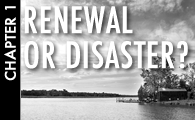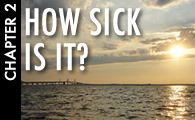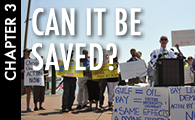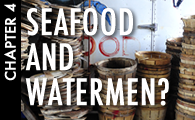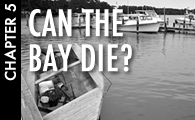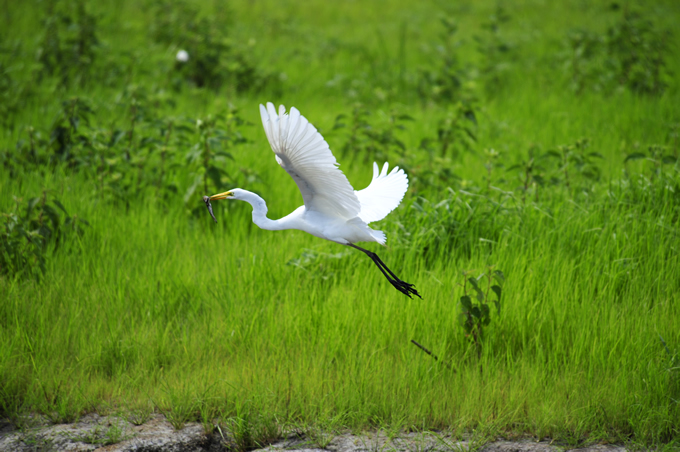
A white heron takes flight at Blackwater National Wildlife Refuge outside Cambridge, Md. (Photo by Jason Lenhart - News21)
Chapter 5: And if the Bay Can't Be Saved?
What might be left if crabs, oysters and watermen all disappear, and the underwater dead zone grows even larger, and bacteria keep thriving from seeping manure and sewage, and industrial chemicals continue to wash off city streets and sidewalks for decades to come?
Could the bay die?
Some who earn their living off the bay’s beauty worry that the Chesapeake already has become a mythical body of water, an illusion that exists mostly in people’s minds.
Bill Wilhelm, innkeeper of the Victorian-era Parsonage Inn in St. Michael’s—a town replete with restaurants and quaint stores selling painted wood duck decoys and floppy sunhats—says there is a wide gap between the reality of the bay and the romantic fantasy of it that drives happy-to-spend tourists to the area.
“They have an idyllic view of what the bay might have been,” he says, sitting in the inn’s miniature green-leafed garden. “They have a mind’s eye view of what the bay is and what it was. We have to preserve that.”
The fantasy is drawn on the canvas of the Chesapeake’s history of a bay replete with oysters, crabs, fish, of swaying underwater grasses and gliding blue herons gently skimming the waters – a dream kept alive by manicured marinas and crab-cake specials in waterfront cafes.
Tom Horton, who has authored seven books on the Chesapeake, sees cause for both optimism and skepticism.
“Politically, the stars are about as aligned as they’ve ever been for a while, so we may make some real progress,” he says, sitting comfortably on a wood lawn chair on the shores of the Nanticoke River, near where he lives.
But after nearly 40 years of ‘Save the Bay’ bumper stickers, Horton says he’s “learned not to get excited and jump up and down just because Obama issued an executive order.”
Even if the latest restoration strategy fails, Horton believes the estuary is too resilient to totally die. Rather, he sees it becoming more like it is now—what he calls “Chesapeake Lite,” a dude-ranch equivalent of the Chesapeake, a Disney-like version of life built around what was once hundreds of thriving shoreline communities.
What will be left is “kind of pretty,” he speculates. “And we’ll sit [at] bars, and we’ll have our former oyster skipjacks carry tourists out there. It will look real pretty with the sunset and, you know, we’ll keep it from getting too nasty and too foul.”
Diaz sees a worse scenario. Without constant and even increased efforts to cut off pollution, he says the Chesapeake Bay could collapse entirely – just as the Baltic Sea and Black Sea have done, creating an ecosystem that would be just a shell of its former self.
“The bay will be here,” Diaz says, but instead of hosting fish, crabs and oysters, it will host bacteria. “So, if you love bacteria, we are in good shape.”
Shultz, the St. Michael’s barista, is horrified by the prospect that the waters could die.
“I can’t hardly fathom it,” he says, standing behind a counter of flavored coffees. “If I had to imagine it, it would be like a massive mud puddle. If there was no plant life or sea life, that would eliminate several species of birds; it would take a lot of the air wildlife away--the geese, the seagulls, swans, everything. Everything would kind of go away.”
“If the bay were to just fall apart and die, we would have no crab, no oysters, the economy would crumble … Nobody’s going to want to have waterfront property on the edge of a mud bank, nobody’s going to want to go out and ride their boat under the Bay Bridge if there are no birds, no white herons, no blue herons, no fish to catch.”
So while there has been progress – agricultural-related nitrogen and phosphorous loads are down in the bay, and decision-makers are more aware of the need to cut back pollution and restore the bay’s fisheries – the question remains if enough is being done, and whether the bay’s dead zones are an indication of the slow death of waters around the globe.
“The spread of dead zones around the world has been accelerating,” says Diaz. Where there were 20 or 30 such zones in the 1960s, there are more than 500 today, mostly off the coasts of the United States and Europe.
“The number of dead zones we have globally does point to the fact that human beings have pretty much screwed up a lot of our coastal areas,” he says.
Scientists like Beth McGee, who has dedicated a large part of her life to improving the Chesapeake Bay, sees the work as a model for ecosystems around the world.
“If we can’t save a resource where we have the scientific know-how, we know what to do, the nation’s capital is right here. . .If we can’t save this ecosystem, then what hope do we have really to save any other estuary in the world?”

